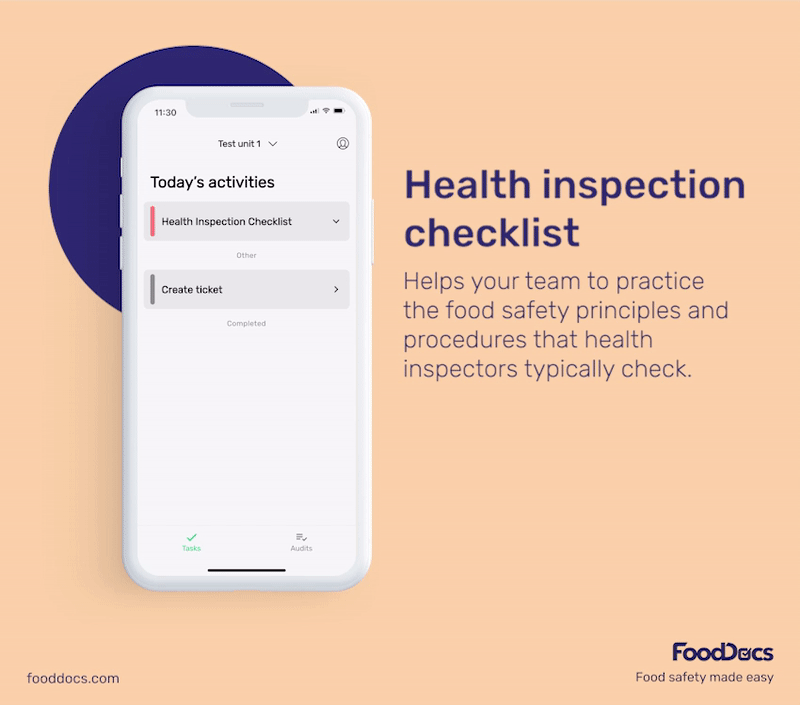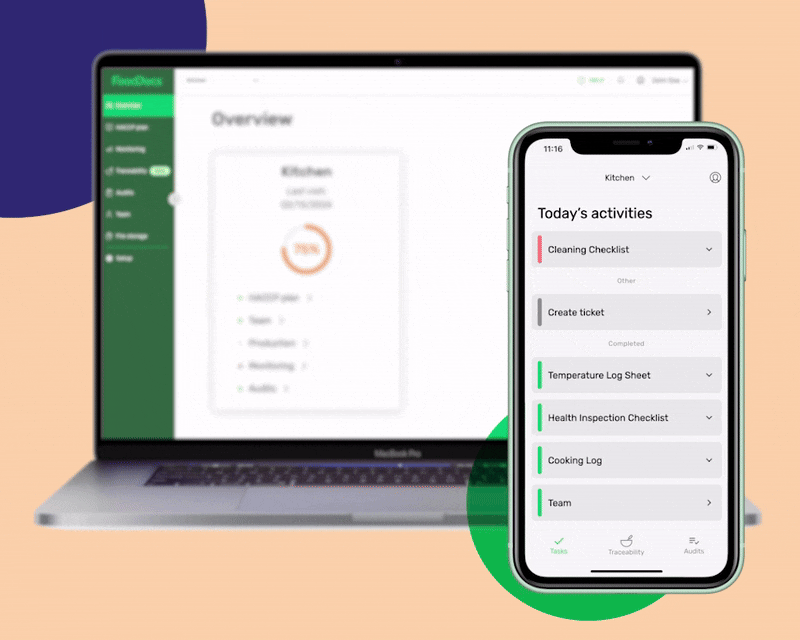Why Is Food Safety Important In Healthcare? Healthcare Leaders Guide
Learn challenges healthcare foodservice teams face today and key food safety practices to protect vulnerable patients. Get a free healthcare leader...
Foodborne illnesses are a product of poor food safety practices in an establishment. In addition to serving quality foods, learning how to prevent foodborne illnesses from occurring is part of the responsibility of food handlers to consumers.
Preventing the occurrence of foodborne illnesses is a year-round task. It is an important part of a food handler's food safety training. Every day, food safety and hygiene practices must be religiously applied to minimize the risk of illness. In doing so, food businesses also help minimize economic loss and help promote sustainability. With fewer cases of foodborne illnesses every year, the workforce and food supply can normally function.
Find out the most important ways of how to prevent foodborne illness.
Key takeaways
Foodborne illness results from consuming contaminated foods and beverages.
The best prevention against foodborne illness is regular and proper food safety practices.
Handwashing is one of the easiest and most effective methods to prevent foodborne illness.
Foodborne illnesses result from poor food safety practices and can significantly impact customer retention and business reputation.
Preventing foodborne illness is crucial for minimizing economic loss and promoting sustainability in the food supply.
Food safety training is essential for food handlers to understand and implement practices that minimize illness risks.
Foodborne illnesses can be caused by factors like inadequate cooking temperatures, poor personal hygiene, and improper food storage.
High-risk groups such as pregnant women, young children, the elderly, and those with weakened immune systems are more susceptible to foodborne illnesses.
A food safety management system (FSMS) is crucial for preventing foodborne illness in food establishments by maintaining continuous safety practices.
FoodDocs' food safety management software can enhance the organization and compliance of food safety practices, making it easier to maintain high standards consistently.
We'll start with how to prevent foodborne illness but include more general info below.
Here are the 10 ways to prevent foodborne illness
Perhaps one of the easiest and most effective ways to prevent foodborne illnesses is to properly wash your hands. Major contaminants can be transferred from one place to another through a food employee's hand. As such, regular hand washing must be done before, in between, and after service. In addition, this task must be properly done to increase efficacy.
Use soapy water and wash your hands for at least 20 seconds to ensure that your hands are free of any pathogens. Check out this handwashing poster for your reference.
In addition to hand washing, other personal hygiene practices may include wearing of clean uniform, using hairnets, regularly clipping nails, and covering your mouth and nose with your sleeve when sneezing are important.
You can prevent foodborne illness by ensuring that your food employees are in good health and that any sick food handler must not attend service. Some pathogens such as viruses can be transmitted to food from a human carrier.
Another route for cross-contamination of food is through equipment and utensils to food. With limited space and equipment, some restaurants won't be able to accommodate separate sets for raw food and ready-to-eat ones. Bacteria on kitchen surfaces can easily transfer to any cooked products.
As such, regular cleaning and sanitation in between use must be practiced. All kitchen surfaces that come in contact with food must be cleaned at least every 4 hours or every after preparing raw food. Use disinfectants and paper towels or clean cloths for cleaning surfaces.
For utensils such as knives and cutting boards, using separate sets for preparing raw and cooked foods is a must. Raw foods have a higher risk of containing harmful bacteria and these can remain on the chopping boards.
Once ready-to-eat foods come in contact with these utensils, they can easily spread foodborne diseases. Ready-to-eat foods require little to no food prep process and therefore will retain the pathogens on their surface once contaminated.
During storage, safe food can also get contaminated. This reason is why we suggest properly categorizing foods based on their type (e.g., ready-to-eat, raw, requires medium processing, etc). Cases such as blood drippings from raw meat can contaminate other foods.
In addition, perishable food must be kept in a tight container to protect them from contaminants. The correct temperature during storage plays a very important role in keeping foods fresh and away from food safety hazards.
With a constant refrigerator temperature of around 40°F (4°C), the growth of bacteria and other pathogens is slowed down or stopped. A refrigerated food stays wholesome for a longer time than foods that are not held at cold temperatures.
For foods that are meant to be served later, such as in a cafeteria setting, holding them at a particular temperature is important. To keep food safe, it must stay out of the temperature danger zone where bacteria in food multiply significantly faster.
Chill foods under a proper temperature of 40°F (4°C), whereas hot foods must be kept hot by storing them in a chafing dish to maintain at least 135°F (57°F) and above.
Since almost all raw materials have naturally occurring microorganisms, the only way to render them safe for consumption is to thoroughly cook them. To do this, foods such as raw meats must reach a recommended internal cooking temperature to ensure thorough processing up until their cold spots.
Using a clean meat thermometer as a guide, the internal temperature must reach the safe range. This ensures that all spots in food have been equally treated with heat to deactivate the pathogens.
A good source of foodborne pathogens is food waste. Not to mention, food waste attracts pests, which carry some of the most dangerous foodborne pathogens. You can prevent food poisoning by implementing a food waste management plan that will cover how to properly dispose of waste and the frequency of disposal.
With several multiple dishes in a restaurant, a lot of raw materials are bound to come in and out of your storage area. To ensure that the food you will be serving at your restaurant establishment is safe, always monitor the expiration dates of your commodities and commercial products.
With proper storage, raw materials can be safely used up until their recommended date of use. Practice the First-In-First-Out system to avoid any raw material from going bad.
If the raw materials that you receive are already in bad condition, the risk of causing foodborne illnesses is still high even with cooking and proper handling. Only source your raw materials from reputable suppliers and require them to submit proof of regular testing.
Your approved suppliers must be able to uphold the same level of food safety standards as your food business. This must also apply to your source of tap water.
In addition to implementing these food safety practices, constant monitoring is a must. A working food safety management system includes a monitoring system for every food safety task. At FoodDocs, we offer a smart solution to monitoring your operations. We've taken the traditional FSMS to a whole new level and created a digital platform for food businesses.
Our digital FSMS features digital monitoring forms that can save your employees' time through its auto-fill feature. All that is left to do for your employees is to verify the logged information.
In addition, no food safety task will get left behind as our digital FSMS features a smart notification system that alerts food handlers of any food safety task to be done. Switching to our digital solution would only require you to answer some basic questions and you will get a complete digital FSMS in an average of 15 minutes.
Seafood and other seafood products have been linked to several different foodborne illnesses such as cholera and typhoid fever. The pathogens that made people sick in these food poisoning cases are known to be also found in contaminated water sources. Similar to any other raw materials, seafood and seafood products can either have naturally occurring pathogens or have these pathogens that cause bacterial infection introduced during preparation.
In a food establishment, you can best prevent foodborne illness by implementing the following food handling practices:
Under the ruling of the Food and Drug Administration of the US, seafood manufacturers are required to implement food safety plans that contain ways to prevent any foodborne infection specific to seafood products. Learn more about the seafood HACCP.

Any foodborne illness results from the consumption of contaminated foods with biological, chemical, or physical hazards. To date, more than 250 different foodborne illnesses have been identified by the Centers for Disease Control and Prevention. The majority of these illnesses are caused by biological contaminants such as bacteria, viruses, and parasites. Other cases of foodborne illnesses have also been reported to be caused by toxins and chemical contamination of clean food.
As previously mentioned, foodborne illnesses result from poor food safety practices and careless food processing. The tasks under a food safety plan encourage having a clean and safe environment to minimize the occurrence of pathogens and other hazards.
Foodborne illnesses may be caused by the following factors:
These mentioned factors can promote the growth of bacteria and other pathogens and creat hazardous foods. Improper food handling has resulted in many issues such as foodborne illness outbreaks in the past. Undercooked meat has been linked to cases that have resulted in severe gastrointestinal symptoms, hospitalizations, and even death in some cases.

All consumers exposed to a food safety hazard are similarly exposed to the risk of having a foodborne illness. Although, some high-risk groups are more likely to get a foodborne illness even with minimal exposure to a food hazard.
This group consists of the following:
These individuals have a weakened immune system when compared to a healthy person. Therefore, they are more likely to get affected by a foodborne illness. Chances are, the effects of a common foodborne illness can inflict severe symptoms in their case.
Depending on the degree of food contamination, even a perfectly healthy person can get sick. They can also experience common symptoms such as abdominal cramps or stomach flu. This is why attention to food safety is important.

As we wrote in our guide to foodborne illness, symptoms of foodborne illness include:
In a restaurant or any food establishment, your team must be well-prepared to address and control any potential hazards that may be present. Your team is required to implement a food safety management system (FSMS) with the objective of monitoring and ensuring that all food safety practices are performed correctly and on time. In addition, this system will include a list of food safety practices to help keep your food establishment free of hazards and your consumers safe from foodborne illnesses.
To help you answer the question "What is the most important way to prevent a foodborne illness from bacteria?" and come up with the most important food safety practices for your food establishment, we've listed 10 basic yet effective ways to do this.

Simply knowing how can you prevent foodborne illnesses and the basics of food safety may not be enough to control them from occurring. Proper and regular implementation is required to ensure their effectiveness. Using a traditional FSMS, you can do this but by the end of the month, your file cabinets will already be filled with monitoring forms.
In addition, a traditional FSMS does not ensure that your food employees will not forget some of the most important food safety tasks. What you need is an FSMS that will help you efficiently get the job done fast, while giving you detailed progress reports and enough time to manage your business.

At FoodDocs, we offer our digital Food Safety Management System. Built by our team of food safety experts, this digital solution promises to significantly increase the efficiency of your food safety system and ensure that every task gets done on time and correctly. The process of switching to our digital solution is not that complicated. In fact, all it takes is for you to answer a few basic questions about your operations, and our system will automatically generate a comprehensive digital FSMS for you!
What's even greater is that the whole process will only take an average of 15 minutes! In that amount of time, our system can automatically tailor the digital FSMS to your daily operations.

What is exactly in a digital FSMS, you ask? Here is a list of what you will get:
You do not need to be tech-savvy to use our system. At FoodDocs, we want to make food safety compliance attainable for everyone - even those that hate digital platforms. With our system, you do not have to face any hassle as the switch itself will only take 15 minutes. Additionally, our team of expert customer support can help you set up and improve your digital FSMS.
Start your food safety journey with us by availing of our free, 14-day trial. Use this free trial to work your way around and experience our digital FSMS.
Learn challenges healthcare foodservice teams face today and key food safety practices to protect vulnerable patients. Get a free healthcare leader...
Learn what Standard Operating Procedures (SOPs) are and how to write effective SOPs that ensure consistency, efficiency, and safety in your...
Boost your retail food safety with essential practices and digital tools to protect customers and your brand. Plus a free Retail Food Safety Leader...